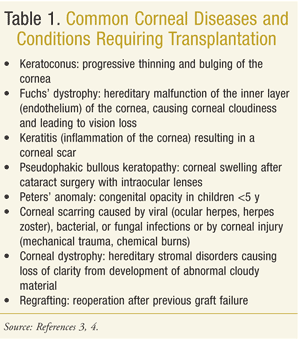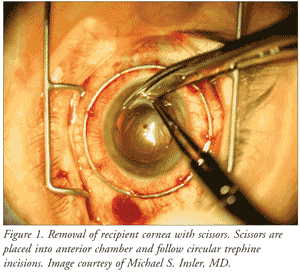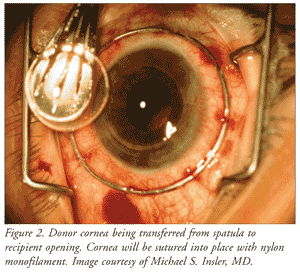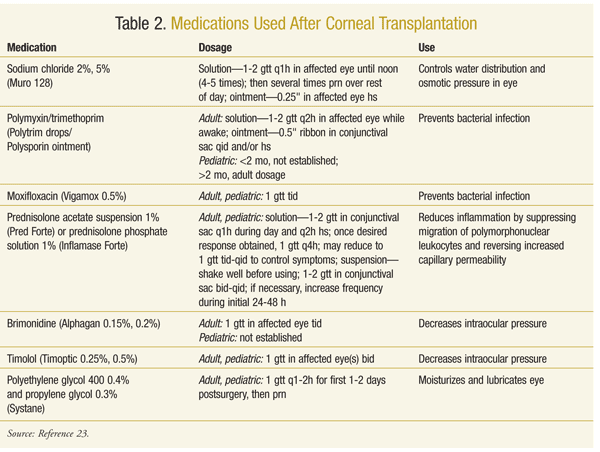US Pharm. 2011;36(4):HS-19-HS-27.
In 2001, the World Health Organization reported that more than 135 million people had impaired vision in both eyes.1,2 Eye diseases affecting the cornea are the primary risk factor for blindness. Corneal grafting is indicated when corneal damage due to disease or traumatic injury causes vision loss. TABLE 1 lists common conditions that cause corneal blindness and may necessitate corneal transplantation.3 Most cases of blindness are due to corneal scar or active keratitis.3

CORNEAL ANATOMY
The cornea, a transparent membrane covering the anteriormost portion of the eyeball, provides protection, clarity, and refractive power to the visual system. It has a diameter of 11.5 mm to 12.00 mm and a central thickness of approximately 0.55 mm (550 µm). The cornea is a five-layered structure nourished anteriorly by the ocular tear film and posteriorly by the anterior chamber.4
The five layers of the cornea are the epithelium, Bowman’s layer, stroma, Descemet’s membrane, and endothelium.4 The epithelium, which is approximately 50 µm thick, is multilayered (5-6 rows of cells) and nonkeratinized. Unmyelinated nerve endings are found here. The epithelium secretes a thin, acellular basement membrane, which forms tight adhesions to the corneal stroma. Epithelial cells rapidly replicate after injury or following transplantation.4
Bowman’s layer is a homogeneous, acellular condensation of the anterior stroma. The stroma, which constitutes about 90% of the cornea’s thickness, consists primarily of water (70%) and collagen (connective tissue); it contains no blood vessels. The arrangement of the collagen gives the cornea its strength, elasticity, and shape, which are important in producing the cornea’s transparency.4
Descemet’s membrane, a thin, strong sheet of tissue that serves as a protective barrier against infection and injuries, thickens with age. It is secreted by the endothelium (its basement membrane), which is the thin, innermost monolayer of tissue that maintains corneal transparency by pumping fluid out of the stroma. Once endothelial cells are destroyed by disease or trauma, they are permanently lost. Loss of the corneal endothelial cell layer causes stromal swelling (corneal edema), with disruption in the function and transparency of the cornea. When the cornea becomes cloudy, light cannot penetrate the eye to reach the retina, resulting in a loss of visual function.4
Although adult corneal endothelial cells do not replicate, neonatal corneal endothelial cells have been grown in tissue-culture media and allowed to attach to microcarrier beads.5 These cell-coated microspheres have been placed on donor corneas and successfully transplanted in animal models.5
CORNEAL TRANSPLANTATION
The cornea was one of the first successful allografts using human tissue. Corneal transplantation involves removing the diseased cornea and replacing it with a new cornea (from a cadaver). Corneal transplantation is common in the United States, with about 40,000 procedures done each year.6
Performed when the eye disease cannot be treated noninvasively, corneal transplantation is usually indicated to restore vision. It is also performed for therapeutic reasons, as in recalcitrant keratitis (corneal ulcers) resistant to medical therapy, and for reconstructive purposes to improve the integrity of corneas that have been damaged by loss of stroma due to thinning diseases.3
Factors affecting the success of corneal transplantation include corneal pathology (presence of vascularization); coexisting ocular disease, such as glaucoma or dry eyes; quality of the donor material (time from harvest to surgery); type of keratoplasty; and surgical techniques and postoperative management of complications.3
Donor Corneal Tissue
The Eye Bank Association of America procures, prepares, and distributes donor corneal tissue for transplantation. The tissue utilized for transplantation consists of homografts (allografts). Because of the absence of blood vessels, corneal homografts are considered “immunologically privileged” tissue.7
The tissue is prepared from an enucleated eyeball within hours after death. The entire cornea, with 2 mm to 3 mm of sclera (white outer wall), is removed from the eyeball and stored at 4°C in special tissue-culture media with antibiotics. It is imperative to use a fresh specimen (3-5 days after procurement) so that the endothelium is viable. The metabolic function of the endothelium is responsible for corneal-graft clarity. Before transplantation, the cornea is examined for artifacts and folds (stromal swelling), and the donor endothelium is assessed.8
SURGICAL TECHNIQUES
New developments in sutures, instruments, and microscopes, as well as changes in surgical techniques, have significantly improved the prognosis of patients requiring corneal transplantation. This has allowed for faster and better recovery from surgery.
Penetrating Keratoplasty (PKP)
This highly successful technique (full-thickness keratoplasty) is the most commonly performed method of corneal transplantation; more than 90% of all corneal transplantations in the U.S. are done using this procedure.9 PKP is performed for central deep opacities in the visual axis, keratoconus, and disorders affecting the corneal endothelium resulting in edema and loss of corneal clarity, as well as when visual acuity is reduced or limited with spectacles and/or contact lens fittings.
Visual loss in the cornea may be the result of edema (Fuchs’ dystrophy), opacity, scarring, or an irregular surface (keratoconus). PKP can yield excellent visual acuity, but it is more prone to serious intraocular complications and a higher rate of rejection compared with the lamellar procedure (discussed later).10-12
In PKP, a Flieringa ring is sutured to the sclera for support to prevent the eyeball from collapsing when the anterior chamber is entered; the center of the diseased recipient cornea is then marked for centration of the trephine.13 The diameter of the trephine must be sufficient to remove most of the pathology. On average, a diameter of 7.5 mm for the donor cornea and 8.0 mm for the recipient is preferred to avoid postoperative complications. Larger grafts (9-10 mm), which are rarely used, have a higher incidence of rejection.
A Barron suction trephine is centered over the mark and suction applied. After the trephine is removed, the wound is inspected and the anterior entered with a sharp blade. The anterior chamber is reinflated with viscoelastic material to maintain the integrity of the eyeball, and the recipient cornea is removed with corneal scissors (FIGURE 1).8

A trephine (usually slightly bigger than the recipient) is then used to punch the donor material from the endothelial side, keeping the corneal endothelium as intact as possible. The graft is then placed over the recipient opening (FIGURE 2). Viscoelastic material is squirted over the pupillary area to support the graft and prevent endothelial damage. The graft is sutured into the host and securely fastened to avoid postoperative complications, such as wound leaks. Size 10-0 nylon monofilament sutures are routinely used because they are less likely to cause inflammation.8

Recent reports have demonstrated some advantages to cutting the donor and recipient corneas with a femtosecond laser.14 There was some benefit from the laser incision—namely, faster visual recovery and less induced astigmatism.
PKP may be performed under topical, local, or general anesthesia, and in most cases it is done on an outpatient basis. Postoperative care consists of lubrication and application of topical antibiotics and steroids (TABLE 2). It is imperative to watch for signs of graft thickening, which may be related to graft failure, rejection, or hypotony (low intraocular pressure).8
Suture status is extremely important in the visual rehabilitation of the corneal graft. Even though the PKP may be crystal clear, the suture pattern may cause significant graft compression, resulting in a highly irregular or astigmatic surface. The continuous suture is well tolerated and may remain in place for 12 to 24 months. Loose sutures, which can cause infection, irritation, and inflammation, must be removed.8
Significant intraocular complications include defective donor material that may be infected (may have low endothelial count and never clear) and prolapse of the iris and/or lens after the anterior chamber is opened. A shallow anterior chamber or low intraocular pressure may be the result of a wound leak, which should be repaired by additional suturing. The same is true of a wound dehiscence (opening), which can be resutured to maintain graft integrity.15
Early diagnosis and treatment of complications are important for preventing loss of vision postoperatively. Patients should report changes in visual acuity that persist beyond 24 hours. Recurrence of preexisting disease, such as herpes, or graft invasion by preexisting dystrophy is possible. The Herpetic Eye Disease Study has shown that prophylactic antivirals (e.g., acyclovir) can prevent recurrence of herpetic keratitis.16
Graft rejection, a cell-mediated immune response, typically occurs at the end of the third week (allowing for graft sensitization by the recipient), but it can occur years after successful PKP. To aid in early recognition and treatment, patients are advised to report a drop in their visual acuity.
An initial epithelial or stromal rejection may progress to endothelial rejection. Loss of endothelial cells from the immune response will cause permanent graft loss, necessitating regrafting. Systemic and topical corticosteroids (administered hourly) are used to treat the immune reaction.
Lamellar Keratoplasty (LKP)
LKP is a more time-consuming and technique-sensitive operation that removes only the outer layers of the stroma, but not Descemet’s membrane and endothelium, as in PKP. In this procedure, a partial-thickness incision is made, followed by dissection of the diseased cornea, which is replaced with either preserved or fresh donor tissue. Advantages of this technique include early suture removal and decreased rejection risk. LKP is usually performed for superficial opacities (scarring) when the corneal endothelium is normal, and it is the procedure of choice for reconstructive purposes.
The dimensions of the donor graft are determined by dissection of the recipient. A circular trephine is used to outline the area to be resected, and a mark may be made on the cornea to help with centration. Extreme care is taken to avoid penetration into the anterior chamber, since one of the advantages of LKP is that it is not necessary to enter the eyeball.
After the graft is transferred to the recipient bed, it is sutured into position with fine (9-0 or 10-0) monofilament. The knots are rotated and buried in the recipient stroma. Postoperatively, sutures are removed immediately if they are too loose, or else beginning 2 to 3 weeks after the operation. Antibiotics and steroids are injected subconjunctivally at the close of the procedure.
Complications of LKP include difficulty dissecting the recipient bed, corneal perforation, infection, and graft rejection.
Deep Anterior Lamellar Keratoplasty (DALK)
Unlike PKP, this technique preserves Descemet’s membrane and the corneal endothelium. Visual recovery is quite good with early visual rehabilitation.17,18 Using the big-bubble technique, the donor graft is positioned after a deep stromal dissection; the femtosecond laser may also be used.19,20
Descemet’s Stripping Automated Endothelial Keratoplasty (DSAEK)
A new procedure, DSAEK (along with a similar method, Descemet’s membrane endothelial keratoplasty) shows similar cell loss overall compared with PKP.21,22 Additionally, there are far fewer complications with DSAEK—including less recovery time, fewer refractive changes, and fewer wound and suture complications—with this method than with PKP.9,15,16 Preparation of the donor disc (about 100 microns) and insertion techniques are more complicated.23,24
Keratoprosthesis
In this technique, an artificial cornea, or prosthesis, is fixed to the surrounding cornea and adjacent structures. The optical portion of the device is plastic, and the surrounding or anchoring material may be a combination of tissue mesh and other substances (bone, periosteum).2 A keratoprosthesis is used after multiple PKP failures and in the case of chemical burns and diseases such as ocular pemphigoid and Stevens-Johnson syndrome. Infection is problematic with these artificial corneas.
Types available include nut-and-bolt keratoprosthesis and keratoprosthesis with an interlamellar skirt for support.25 The Boston type 1 keratoprosthesis has shown significant postoperative vision improvement and a high rate of graft retention; however, glaucoma has been a significant cause of poor outcomes.26
POSTOPERATIVE CARE
The reduction and management of postoperative astigmatism (irregular curvature) and graft rejection continue to be major problems, particularly after PKP. Medications are used to prevent corneal edema, inflammation, infection, and rejection. TABLE 2 lists medications used following corneal transplantation.

OUTCOME ASSESSMENT: GRAFT REJECTION
The overall survival rate of corneal grafts is 64.5% to 91% at 5 years and 64% at 10 years; predicted graft survival at 20 years is 37%.3,17 A major cause of corneal graft failure, graft rejection is the patient’s immunologic response to the grafted donor cornea.27 Graft failure is defined as a condition rendering regrafting necessary or a cloudy cornea that compromises vision for a minimum of 3 consecutive months.28
It is well documented that the risk of graft failure increases with the presence of vascularization before surgery.6 Most graft rejections and failures occur in the early postoperative period.29 Regarding recipient age, patients aged 13 to 19 years show better corneal graft survival than those aged up to 12 years.30,31
TREATMENT OF CORNEAL GRAFT REACTIONS
The standard for early treatment for corneal graft reactions is to use corticosteroid eyedrops. Clinical signs of reactions include redness, sensitivity to light, decreased vision, and pain; when experienced after the initial healing period, these signs should be reported to the ophthalmologist.8 The earlier treatment is applied, the more effective it is likely to be. Oral and topical cyclosporine have been used successfully to treat corneal graft rejection, and some benefit may be derived from cyclosporine eyedrops.32 Patients who have had previously rejected corneal grafts or who are at high risk for rejection may be pretreated with immunosuppressive agents (e.g., azathioprine, cyclosporine).33,34
CONCLUSION
Corneal transplantation has undergone enormous improvements in surgical techniques and eye banking during the past 50 years, making it one of the most successful forms of organ replacement. The advent of new procedures, such as DSAEK, has greatly shortened the recovery period, and bioengineering breakthroughs are beginning to show promise for synthetic corneas. Finally, refinements in drug delivery and potency are being used successfully to improve outcomes following graft rejection.
REFERENCES
1. Whitcher JP, Srinivasan M, Upadhyay MP. Corneal blindness: a global perspective. Bull World Health Organ. 2001;79:214-221.
2. Arora S, Bandukwala T. Corneal transplantation: dental lamina as keratoprosthesis. McMaster Univ Med J. 2010;7:11-14.
3. Garg P, Krishna PV, Stratis AK, Gopinathan U. The value of corneal transplantation in reducing blindness. Eye. 2005;19:1106-1114.
4. National Eye Institute. Facts about the cornea and corneal disease.
www.nei.nih.gov/health/
5. Insler MS, Lopez J. Transplantation of cultured human neonatal corneal endothelium. Curr Eye Res.
6. Bachmann B, Taylor RS, Cursiefen C. Corneal neovascularization as a risk factor for graft failure and rejection after keratoplasty: an evidence-based meta-analysis. Ophthalmology. 2010;117:1300-1305.e7.
7. Reed C. The changing face of eye banking. Part one: structure and function. Insight. 2011;36:26-27.
8. Albiani DA, Campbell RJ, Hodge WG. Immunologic diseases of the eye. In: Riordan-Eva P, Whitcher JP. Vaughan & Asbury’s General Ophthalmology. 17th ed. New York, NY: McGraw-Hill Medical; 2008.
9. Pramanik S, Goins KM, Sutphin JE. Corneal endothelial transplantation: Descemet’s stripping endothelial keratoplasty (DSEK). EyeRounds.org.
www.EyeRounds.org/cases/54- 1986;5:967-972.
10. Insler MS, Cooper HD, Kastl PR, Caldwell DR. Penetrating keratoplasty with trabeculectomy. Am J Ophthalmol. 1985;100:593-595.
11. Insler MS, Pechous B. Visual results in repeat penetrating keratoplasty. Am J Ophthalmol. 1986;102:371-375.
12. Hodkin MJ, Insler MS. Transplantation of corneal tissue from a blind eye to a high-risk fellow eye by bilateral penetrating keratoplasty. Am J Ophthalmol. 1994;117:808-809.
13. Insler MS, Cooper HD, Caldwell DR. Final surgical results with a suction trephine. Ophthalmic Surg. 1987;18:23-27.
14. Farid M, Steinert RF. Femtosecond laser-assisted corneal surgery. Curr Opin Ophthalmol. 2010;21:288-292.
15. Boutros G, Insler MS. Surgical management of traumatic wound dehiscence following penetrating keratoplasty. Ophthalmic Surg. 1985;16:643-644.
16. Barron BA, Gee L, Hauck WW. Herpetic Eye Disease Study. A controlled trial of oral acyclovir for herpes simplex stromal keratitis. Ophthalmology. 1994;101:1871-1882.
17. Borderie VM, Boëlle PY, Touzeau O, et al. Predicted long-term outcome of corneal transplantation. Ophthalmology. 2009;116:2354-2360.
18. Terry MA, Ousley PJ. Deep lamellar endothelial keratoplasty in the first United States patients; early clinical results. Cornea. 2001;20:239-243.
19. Anwar M, Teichmann KD. Big-bubble technique to bare Descemet’s membrane in anterior lamellar keratoplasty. J Cataract Refract Surg. 2002;28:398-403.
20. Buzzonetti L, Laborante A, Petrocelli G. Standardized big-bubble technique in deep anterior lamellar keratoplasty assisted by the femtosecond laser. J Cataract Refract Surg. 2010;36:1631-1636.
21. Price MO, Gorovoy M, Benetz BA, et al. Descemet’s stripping automated endothelial keratoplasty outcomes compared with penetrating keratoplasty from the Cornea Donor Study. Ophthalmology. 2010;117:438-444.
22. Rose L, Briceño CA, Stark WJ, et al. Assessment of eye bank-prepared posterior lamellar corneal tissue for endothelial keratoplasty. Ophthalmology. 2008;115:279-286.
23. Taravella M, Walker M. Cornea edema, postoperative: treatment & medication. eMedicine.
http://emedicine.medscape.com/
24. Goins KM. Surgical alternative to penetrating keratoplasty II: endothelial keratoplasty. Int Ophthalmol. 2008;28:233-246.
25. Cardona H. Keratoprosthesis; acrylic optical cylinder with supporting intralamellar place. Am J Ophthalmol. 1962;54:284-294.
26. Zerbe BL, Belin MW, Ciolino JB. Results from the multicenter Boston Type 1 Keratoprosthesis Study.Ophthalmology. 2006;113;1779.e1-e7.
27. Jacobs J, Taravella M. Corneal graft rejection. eMedicine.
http://emedicine.medscape.com/
28. Gal RL, Dontchev M, Beck RW, et al. The effect of donor age on corneal transplantation outcome: results of the Cornea Donor Study. Ophthalmology. 2008;115:620-626.
29. Vail A, Gore SM, Bradley BA, et al. Conclusions of the Corneal Transplant Follow Up Study. Br J Ophthalmol. 1997;81:631-636.
30. Lowe MT, Keane MC, Coster DJ, Williams KA. The outcome of corneal transplantation in infants, children, and adolescents. Ophthalmology. 2011;118:492-497.
31. Huang PT. Penetrating keratoplasty in infants and children. J AAPOS. 2007;11:5-6.
32. Sonmez B, Beden U, Erkan D. Regression of severe corneal stromal neovascularization with topical cyclosporine 0.05% after penetrating keratoplasty for fungal corneal ulcer. Int Ophthalmol. 2009;29:123-125.
33. Chatel MA, Larkin DF. Sirolimus and mycophenolate as combination prophylaxis in corneal transplant recipients at high rejection risk. Am J Ophthalmol. 2010;150:179-184.
34. Sonoda KH, Nakao S, Nakamura T, et al. Cellular events in the normal and inflamed cornea. Cornea. 2005;24:S50-S54.
To comment on this article, contact rdavidson@uspharmacist.com.






